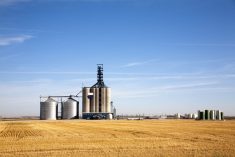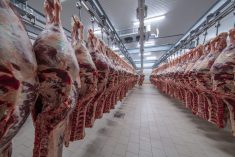SOUTHWEST
Temperatures were near seasonal. No significant rainfall occurred except on the weekend. No killing frost was reported.
Twenty to 25 percent of the cereal harvest is complete. Many cereal fields were harvested at tough and damp moisture levels. Quality is rated as good.
Spring wheat, barley and oat yields continue to be at or above long-term averages.
Canola swathing is almost complete in most areas. Yields are said to be above average.
Pea harvest is roughly 90 percent complete. Yield and quality are very poor in most cases. The flax crop is looking promising.
Read Also

Canadian crop outlook has improved since January says FCC
Canadian farmers’ overall new crop outlook has improved since the beginning of the year, says Farm Credit Canada.
The soybean crop continues to mature..
Silage operations in barley crops are ongoing with average yields. Silage corn is in the dough stage with only leaf burn being noted as a result of the recent frost.
Pastures are holding on. Some cattle are being moved to harvested crop residue for grazing.
NORTHWEST
Scattered showers limited the amount of harvest progress.
Approximately 95 percent of the wheat crop is mature across the region. Wheat harvest varies from less than five percent combined to 95 percent. Wheat yields are reported as average and quality is good.
Roughly 80 percent of the canola crop is swathed. Twenty-five to 30 percent is combined. Canola yields range form 20 bushels per acre to over 30 bu. per acre. The quality is reported as good.
Pea harvest is complete with average yields and good quality. The majority of soybean and flax remain standing.
Little to no seeding of winter wheat or fall rye has occurred.
Producers are beginning to haul hay to winter feeding areas.
Some haying occurred in dry areas. Second cut alfalfa mixes are being harvested as well.
Areas that received frost are reporting issues with nitrates, but water supply on all pastures is good.
CENTRAL
Harvest progress was made, but heavy dews and wet field conditions caused delays. Weekend rain slowed progress.
Harvest is 50 to 80 percent complete.
Winter wheat harvest is complete with yields averaging 50 to 70 bu. per acre. Quality is below average because of fusarium.
Fall rye yields are 50 to 60 bu. per acre.
Spring wheat harvest continues with yields averaging 45 to 80 bu. per acre and higher. Most barley is harvested and yields are 70 to 100 bu. per acre.
Oat yields are 90 to 140 bu. per acre.
Many cereals are harvested at tough or damp moisture levels. Sprouting, mildew, fusarium damaged kernels, and ergot have occurred.
Canola is swathed or left standing for straight cut. Yields are 40 to 45 bu. per acre.
Most soybean fields are seeing colour change and leaf drop. Early harvest reports yields averaging 25 to 40 bu. per acre.
Potatoes are being dug and have good quality.
EASTERN
Harvest continued slowly because of below seasonal temperatures, rainy weather, heavy morning dews and higher cereal grain moisture levels.
Progress was made in spring wheat and canola. Quality losses continue in cereals because of harvest delay and poor weather.
Spring wheat yielded 60 to 80 bu. per acre and canola 30 to 50 bu. per acre. Soybeans are in the R7 to R8 stage.
Corn is in the dent stage. Approximately 50 percent of the acres are at three-quarters milk line.
Sunflowers are in the R7 stage with the back of the head starting to yellow.
Haying progress is slow and pastures are doing well with the recent rains.
INTERLAKE
Seasonal temperatures and light showers occurred across the region. Minimal frost damage occurred, but damage was noted to soybean leaves and cornfields.
Harvest is roughly 45 percent complete. Spring cereals, canola, soybeans, grain corn and sunflowers are still waiting to be harvested.
Crops continue to be harvested at tough moisture levels. Soybean maturity ranges from R6.5 to R8 throughout the region.
Field tillage is scattered throughout the area. Many fields are too wet to enter.
Some second cut haying and ensiling occurred. Pasture conditions are holding up well.















